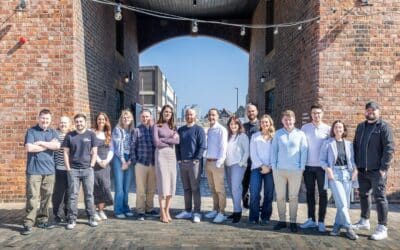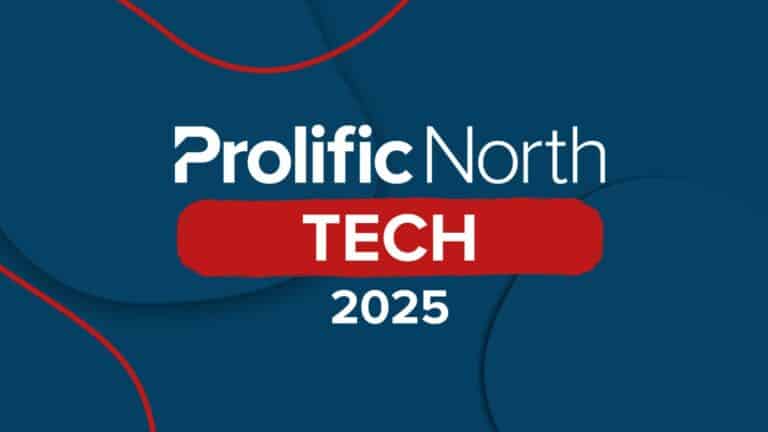In what was another year filled with both tech triumphs and turbulence, unsurprisingly, AI continued to dominate conversations in 2024.
Amid rising geopolitical tension, concerns over online disinformation and cyber threats increased too and was seen in the North as pro-Russian hackers targeted council websites, including Salford, Bury, Trafford and Tameside.
As those digital threats are on the rise, a number of cybersecurity companies received chunks of investment across the region in 2024, with the likes of Cytix and Melius Cyber securing millions in funding to further bolster capabilities and recruit new hires in the new year.
There have been plenty of other good news stories across the North too – with global tech giant UST revealing plans for its growing Leeds base and a hint at Northern expansion, work starting on Kao Data’s new £350m data centre in Stockport, and Teesside’s razorblue opening a new Manchester office, to name just a few.
And Prolific North continued to shine a spotlight on ambitious regional start-ups, showcasing 15 Tech Companies to Watch for the third year in a row where you’ll find companies working on important solutions from tackling the retention crisis in teaching to improving the detection of breast cancer.
With the rapid rise of AI, the acceleration of sustainability to the stark threat of disinformation, we’ve spoken to a number of tech leaders across the North for their insights, trends and predictions for the year ahead in 2025…
Kai Ojo, CEO, Planisware

In 2025, the rise of the project economy will fundamentally reshape how organisations operate, prioritising flexibility and innovation over rigid structures. Projects will become the primary vehicles for delivering value, with tools like Planisware enabling businesses to manage these complex ecosystems effectively.
In the project economy, success hinges on the ability to align portfolios dynamically with strategic objectives. As AI matures, it will not only forecast outcomes but actively recommend optimal resource allocations across competing priorities. This capability will support organisations in navigating uncertainty with agility and precision.
Cross-functional collaboration will reach new heights, fuelled by platforms that break silos and empower diverse teams to work cohesively. The fusion of human expertise and AI-driven insights will redefine the boundaries of innovation. By embracing this transformation, businesses can thrive in an economy where projects are not just tasks but strategic investments driving growth and competitive advantage.
Ed Thompson, CTO and co-founder, Matillion

Whilst we’ve seen AI dominating the tech trends for the past two years or so, over the past six months we’ve seen a move beyond the hype to use cases coming into fruition, with organisations realizing that you cannot have a successful AI project without having the right data to feed it.
With that in mind, I think we’re going to see a huge shift toward the ‘less flashy’ technology that powers the AI mega trend. That means putting the right data stack and team in place, and enabling those team members to manage an increased demand on their time as harnessing AI becomes a focus. Those who get that plumbing in place are the organizations who’ll reap the biggest rewards five or 10 years down the line.
As a data integration platform, of course we’d say that, however, we’re seeing a real gear change of global organisations for example, moving from on-prem to cloud to enable future AI and GenAI projects.
Adam Nethersole, VP at Kao Data

2025 will see an increased demand for data storage and processing, driven by the rapid growth in AI, cloud services and data analytics. With the Greater Manchester Mayor’s ambitions to make Manchester the UK’s leading digital city region, it is well placed to capitalise on the growing demand for data centres and the compute power required to grow these technological capabilities.
As such, we predict that we will see other data centre operators and cloud providers follow the lead of Kao Data, and expand into the North West, and Greater Manchester specifically.
Additionally, due to a moratorium on building new data centres in Dublin, Manchester, at just 166 miles away, and sharing the same world-class connectivity links as Ireland, is well-placed to support Dublin and its hyperscale community. We predict that Manchester and Dublin will begin to form a close bond when it comes to digital infrastructure, providing a much-needed Northern gateway to Europe.
On top of this, we also predict that creating better links with the community will become a bigger priority for large tech businesses moving into new areas, such as our recently-launched Kao SEED Fund for Stockport.
Katherine Megson, Innovation Manager, Bruntwood SciTech

2025 will see generative AI and AI assistants become more nuanced, context-aware and embedded into productivity and customer service tools as incremental improvements continue to be made to the most widely-used platforms.
All this will only become possible, however, as business leaders begin to develop a deeper understanding of ethical AI practices, addressing some of their misconceptions and reservations. It’s from this stronger emphasis on responsible usage, that higher rates of adoption will undoubtedly follow.
Elsewhere, we expect that continued convergence of life sciences and tech, as well as growing momentum in the techbio space, could be accelerated by a greater commitment to R&D support from this new government. In particular, the launch of the upcoming Industrial Strategy – due for release in the Spring – will be a crucial moment for this emerging space.
With digital threats evolving across all sectors, cybersecurity will continue to have to innovate to keep up. This will be especially critical for the major northern fintech hubs of Leeds and Manchester, which should be able to capitalise on their size and scale to work towards developing more sophisticated zero-trust security architectures.
In the property sector, we’ll see the continued integration of proptech platforms to enhance user experience within buildings, focusing on creating seamless customer journeys as well as optimising energy usage and reducing carbon intensity.
Steven Oakes, CMO at Northcoders

Disinformation is now one of the biggest tech trends (although I would say threats) we all face; from fake news to malicious content, hoaxes, phishing and far-right propaganda. Political disinformation has been playing out for a long time, but now more and more brands are starting to suffer from its impact. It can trash reputations, erode public trust and implode employee morale. The fear is that things will only get worse, so businesses, brands and organisations of all types and sizes need to address the issue head on to protect themselves, their people and communities.
That will be no easy task as those engaged in disinformation often exploit systems, platforms and infrastructures that can change a narrative and the truth with catastrophic consequences. It needs to happen, but it will require dynamic and multi-layered strategies that evolve continuously over time.
Leaders should be investing in content validation tools that integrate generative AI and digital forensics to differentiate authentic content from fabricated material and fact from misinformation. They also need to detect impersonation by adopting technologies that go beyond traditional credentialing and authentication, enabling ongoing monitoring and – if needed – defence. The mantra needs to be: Refute With Facts and Amplify With The Truth.
Jonny Clark, who is an angel investor, start-up founder, director of Liverpool Slush’D and leader of Capital Enterprise

I think we’re approaching the natural apogee of the hype cycle when it comes to AI. With the major winners so far being the hardware layer – in particular, Nvidia – there is only so far the elastic band can stretch without snapping. This is why I’m so interested in some of the exciting prospects coming out of the accelerator we run at Turing Innovation Catalyst – it’s the practical application layer that is going to determine what kind of recovery trajectory AI tracks once the initial hysteria fades. A solid set of companies in the application layer will lay the foundations for a stronger, more sustainable growth trajectory (like the internet in the years following the dot com bubble bursting).
Outside of AI, I’m particularly interested in developments around defence technology and other areas required for UK and European ‘resilience’ – so, technological transformation of manufacturing, supply chains, advanced materials and so on… – and I’m excited to see how movements like e/acc and the EU Inc work that Andreas Klinger is driving might have knock-on effects here in the UK.
Defense should be considered ESG in the complex geopolitical environment we’re in – and topics such as driving advances and gains in mining, mineral exploitation and energy abundance (that means nuclear and reliable gas!) should no longer be controversial.
Dan Freed, Partner, YFM Equity Partners

From the rapid rise of AI to the acceleration of sustainability and the promise of quantum computing, the North West’s tech landscape is evolving at breakneck speed. 2025 is set to push boundaries further, with key themes shaping the region’s future: artificial intelligence, sustainability, and groundbreaking technologies like quantum computing.
AI continues to revolutionise industries, with companies such as Biorelate advancing drug discovery and therapeutics, transforming patient care and positioning the region as a global leader in medical technology. Meanwhile, Relative Insight is transforming how businesses leverage qualitative data. By analysing feedback, online conversations, and customer interactions, they enable organisations to quantify insights, visualise trends, and make data-driven decisions that impact KPIs and drive results.
Sustainability remains central. ThinkHire is championing off-grid power solutions, while carbon-neutral strategies gain traction. EV infrastructure advancements, led by Lancaster-based Fuuse, are powering the UK’s clean energy transition.
The North West is not just keeping pace with change but driving it. With the Department for Science, Innovation and Technology HQ opening in Salford, the region is primed to lead the next wave of tech innovation.
Anna Heyes, CEO of Active Profile and founder of Tech Climbers

We’re expecting to see the rise of Gen Z as a decision influencer in tech. It’s vital that organisations begin to adapt their own approaches to remain relevant and competitive.
In 2025, decision-making processes in B2B will move more generations than ever, each with unique priorities and expectations. Organisations must now navigate a landscape influenced by three key groups:
- Gen Z often playing a role as junior researchers and early adopters
- Millennials often driving recommendations, business cases and budgetary approval
- Boomers overseeing strategic priorities and direction setting
Data-driven decisions won’t be enough – Gen Z audiences are bombarded with options, they research thoroughly, and their decisions are swayed by influencers, friends, and communities. Brands must consider the ‘why’ when driving decisions.
Tech brands will need to consider three key pillars to communicate with these new-age decision influencers: societal value, autonomy, and trust. The narrative is no longer about what you sell, but the story behind it. Gen-Z also prefers self-service, so websites will need to be top-notch, offering robust resources such as FAQs and product videos to appeal to the autonomous decision influencer. Finally, brands will need to foster open communication with their audiences through social media, displaying authenticity and the faces behind the name through channels like TikTok.
Companies who are able to embrace this shift in 2025 will shape a lasting legacy that sets them up for success as these younger audiences start to hold all the power.
Kit Muir-Rogers, Co-founder of GigPig

During 2025, I anticipate that technology will further power up personalisation across the music and hospitality sectors, helping gigging artists and hospitality venues to thrive by providing them with more access to in-depth data at their fingertips so they can make data-led decisions.
Insights from our platform such as data on the best times/days for gigs, popular genres and the types of artist which can draw in crowds can be applied to certain venue types. Armed with more of this knowledge next year, bars, restaurants and pubs will be able to curate and stage bespoke live entertainment experiences in their venues which are completely tailored to audience preferences. It will also help gigging artists to understand their market inside out.
This means that the technology available through GigPig’s innovative live music marketplace will help venues and artists to attract audiences and help to keep customers in venues for longer. We’re several years into our journey at GigPig now, and the market is so ready for this surge of information to boost scalability and success.
I also expect that advances to technological booking tools within our platform will make the scheduling process even more intuitive, integrated and accessible for venues. Our model helps venues book gigs from as little as £10 all at the click of the button and our development team are always ahead of the curve. Streamlining these processes in turn will allow operators to have a first-class live music offering. It’s great to know that technology can be a catalyst for change in this way.
David Sarginson, Head of Software Delivery at Opencast

I anticipate several key technological trends in 2025 that will shape our delivery of the UK government’s citizen-facing digital services. AI and machine learning will become integral, enhancing personalisation and automating processes to improve citizen experiences. Low-code and no-code platforms that utilise AI and ML will accelerate application development, empowering non-technical staff and reducing time to market for simple services.
As we store and use more and more data, privacy and security will take precedence, with the adoption of zero trust architectures and stricter compliance with regulations like GDPR. Cloud computing will continue to expand, with a shift toward multi-cloud strategies to enhance resilience and avoid vendor lock-in.
There’s a growing emphasis on digital accessibility and inclusion, ensuring services are usable by all citizens, including those with additional needs. Sustainability and green IT initiatives will gain importance, aiming to reduce the carbon footprint of digital services.
Sarah Pawson, founder and CEO at Enablis

The last couple of years in which businesses have faced challenging economic conditions means that cost optimisation will rank high on the agenda and leaders will look at ways in which technology can be used as a means to achieve that.
2025 is going to be the year of AI being used to streamline and enhance business processes in a really grounded and pragmatic way. Whilst it’s been the shiny new thing that has got people excited – or scared! – over the last couple of years, now is the time that we really start to see it used as a way of modernising regular day-to-day activities. Having wrestled with the idea of what it is, what its full potential might be and how it can be leveraged, business leaders have started to identify areas in their organisational processes where it can make a meaningful difference.
Technology delivery is also something that is undergoing major change, and we’ll see that continue into 2025. In recent years, team dynamics have radically altered through remote working, distributed teams and economic pressures advancing the need to combine local with offshore/nearshore models. This has challenged classic lean/agile principles which accelerated delivery through co-location and close collaboration such that it’s hard to envisage a complete return to the old ways. Lots of organisations are still wrestling with how to reconnect with those values in a very different world – and at some point we will see the emergence of a new de facto methodology which caters for the shifted dynamic.
Dan McBooth, Head of Technology at Naimuri

AI Governance: The Wild West meets reality
As AI continues to make rapid strides, 2025 will be a pivotal year for AI governance. Companies are waking up to the need for more structured and accountable frameworks around the development and deployment of AI technologies. The “wild west” phase of unchecked AI growth is beginning to give way to more defined guidelines on ethics, transparency, and explainability. With AI becoming integral to business operations, organisations will have to grapple with questions surrounding responsibility, fairness, and trustworthiness. Expect AI governance to play a major role in shaping the next phase of AI development.
Data Sovereignty and the questioning of Cloud Computing
Cloud computing revolutionised the way businesses manage and store data, but by 2025, many organisations will start asking difficult questions about the true cost and risks of where and how their data is stored. Data sovereignty will become a focal point as organisations consider where their data is being stored and processed, especially in light of rising concerns over data security, privacy, and government regulations. The increasing costs of cloud services will also drive businesses to seek alternatives, leading to greater interest in hybrid, on-premises, and decentralised solutions.
Phil White, CEO of Audacia

Building on recent momentum, 2025 will see continued evolution and investment in AI and data.
As organisations weigh decisions between deploying AI as centrally controlled platforms for automation vs. decentralised tools for empowerment and creativity – data quality, security and governance will become key challenges.
The emergence of tools like ChatGPT has given non-technical people access to extremely powerful models, through simple web interfaces and chatbots. With interest piqued, many organisations have adopted solutions based on these large pre-trained models – whilst they offer rapid deployment, they can also be costly, inflexible, and often unsustainable in the long term. As a result, we’ll see a shift towards leveraging alternative tools for prediction, creation, automation, and augmentation.
AI investment will likely focus in two key areas: the widespread deployment of large pre-trained commoditised, cloud-based AI agents to augment processes and improve productivity, and the implementation of specialised models trained on proprietary data. This latter approach reflects a growing trend as organisations delve deeper into lower-level statistical and machine learning techniques to unlock value from the data they own. However, with large-scale AI deployments, there’s a pressing need to avoid creating a new breed of bloated, legacy systems. As software technical debt risks evolving into AI and data technical debt.
So, as organisations harness the power of using their own data to train specialised models or improve the functionality of existing pre-trained large models, we’ll see the next phase of AI evolution. If 2024 was the year of AI adoption; 2025 will be the year of data consolidation, governance, analysis, and utilisation – seeing the convergence of software, hardware, data, and AI usher in a new wave of digital innovation.
Also, quantum computing – but probably not for a few years yet.









